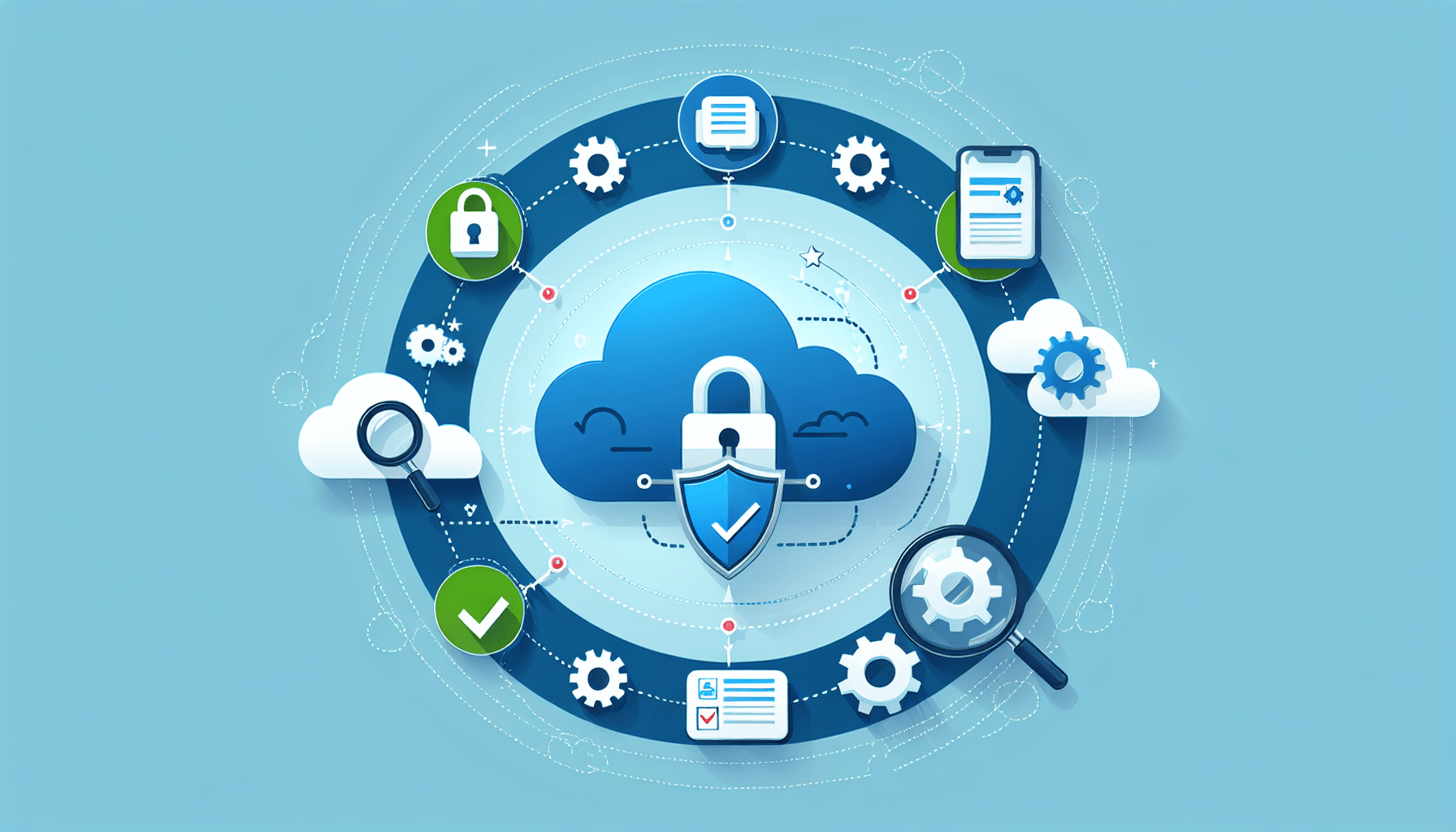In today’s digital landscape, protecting valuable data and information is of utmost importance. With the widespread adoption of cloud technology, organizations must ensure the security of their cloud environments. This article aims to provide a comprehensive and expert guide to conducting cloud security assessments. By identifying and addressing potential vulnerabilities, businesses can effectively safeguard their assets in the cloud. Through the implementation of rigorous assessment techniques, organizations can confidently navigate the complexities of cloud security, mitigating risks and staying one step ahead of potential threats.
Understanding Cloud Security Assessments
What is a cloud security assessment?
A cloud security assessment is a systematic evaluation of the security controls and measures in place within a cloud environment. It involves identifying potential vulnerabilities, analyzing threats, evaluating security controls, and assessing compliance and governance. The purpose of a cloud security assessment is to identify potential security risks and weaknesses, allowing organizations to understand their current security posture and take the necessary steps to address any gaps.
Why are cloud security assessments important?
Cloud security assessments are of utmost importance to organizations utilizing cloud services. With the increasing adoption of cloud computing, the security of cloud environments has become a top concern. Cloud security assessments help organizations protect their sensitive data, intellectual property, and critical systems by identifying and addressing security vulnerabilities before they can be exploited by malicious actors. These assessments also help organizations comply with industry regulations and best practices, build trust with customers, and mitigate potential financial and reputational losses that could result from a security breach.
Types of cloud security assessments
There are various types of cloud security assessments that organizations can choose from, depending on their needs and requirements. These assessments can be categorized into:
-
Risk Assessments: These assessments focus on identifying and evaluating potential risks associated with the use of cloud services. They help organizations understand the risk landscape and prioritize their security efforts accordingly.
-
Compliance Assessments: Compliance assessments ensure that an organization’s cloud environment meets the necessary regulatory requirements and industry-specific compliance standards. They assess the effectiveness of security controls and governance practices for maintaining compliance.
-
Penetration Testing: Penetration testing, also known as ethical hacking, involves simulating real-world attacks to identify vulnerabilities in the cloud infrastructure. It helps organizations understand their security strengths and weaknesses from an attacker’s perspective.
-
Configuration Audits: These assessments evaluate the configuration settings of cloud services and infrastructure to ensure that they align with security best practices. Configuration audits help identify any misconfigurations that could lead to security breaches.
-
Incident Response Assessments: Incident response assessments focus on evaluating an organization’s ability to detect, respond to, and recover from security incidents in the cloud environment. These assessments test incident response plans and ensure they are robust and effective.
-
Third-Party Vendor Assessments: Organizations that rely on third-party cloud service providers must assess their vendors’ security measures. These assessments help verify whether the vendor’s security controls align with the organization’s expectations and requirements.
Key Components of Cloud Security Assessments
Identifying assets and risks
The first step in a cloud security assessment is to identify the assets within the cloud environment that need protection. This includes data, applications, systems, and other resources hosted in the cloud. Once the assets are identified, a thorough risk assessment is conducted to understand the potential threats and vulnerabilities that could impact those assets. The goal is to prioritize the assessment efforts and focus on areas of highest risk.
Analyzing threats and vulnerabilities
After identifying the assets and risks, the assessment dives deeper into analyzing the specific threats and vulnerabilities that could exploit those assets. This involves examining potential attack vectors, assessing the likelihood and potential impact of these threats, and understanding the underlying vulnerabilities in the cloud environment. Comprehensive threat intelligence is gathered to ensure all potential threats are considered.
Evaluating security controls
Evaluating the effectiveness of existing security controls is a critical component of a cloud security assessment. This involves reviewing the implementation and configuration of security measures such as firewalls, encryption, access controls, and intrusion detection systems. The assessment determines whether these controls are properly implemented, meet industry best practices, and provide the necessary protection for the cloud environment and its assets.
Assessing compliance and governance
Cloud security assessments also evaluate the organization’s compliance with industry regulations and governance standards. This involves reviewing policies, procedures, and documentation to ensure they adhere to legal and regulatory requirements. Additionally, the assessment evaluates the organization’s overall governance framework, including risk management practices, incident response procedures, and security awareness training programs.
Testing incident response capabilities
To ensure preparedness for security incidents, cloud security assessments include testing an organization’s incident response capabilities. This involves simulating various security incidents, such as data breaches or system compromises, and evaluating the effectiveness of the response plans, communication processes, and recovery procedures. The assessment aims to identify any gaps or weaknesses in the incident response capabilities and provide recommendations for improvement.

Choosing the Right Cloud Security Assessment Framework
Common frameworks for cloud security assessments
There are several widely recognized frameworks that organizations can use as a basis for their cloud security assessments. Some of the commonly used frameworks include:
-
Cloud Security Alliance (CSA) Security Guidance: This framework provides a comprehensive set of security guidelines and best practices for cloud computing. It covers various aspects of cloud security, including architecture, data protection, identity and access management, and incident response.
-
NIST Special Publication 800-53: Developed by the National Institute of Standards and Technology (NIST), this framework provides a catalog of security and privacy controls for federal information systems and organizations. It offers a robust and well-established set of controls that can be adopted for cloud security assessments.
-
ISO 27001/27002: The ISO 27001 standard outlines the requirements for establishing, implementing, maintaining, and continually improving an information security management system (ISMS) within the context of the organization’s overall business risks. ISO 27002 provides a code of practice for implementing the controls specified in ISO 27001.
Key factors to consider in choosing a framework
When selecting a cloud security assessment framework, organizations should consider the following factors:
-
Relevance: The framework should be applicable to the specific cloud environment and industry sector of the organization. It should address the unique security challenges and requirements of the cloud services being used.
-
Comprehensiveness: The chosen framework should cover all relevant areas of cloud security. It should provide detailed guidance on assessing risks, implementing security controls, and meeting compliance requirements.
-
Credibility: The framework should be widely recognized and respected within the industry. It should have a strong track record of being effective in evaluating cloud security and mitigating risks.
-
Flexibility: The framework should allow for customization based on the organization’s specific needs and requirements. It should provide the flexibility to adapt to different cloud environments and evolving technologies.
-
Support and Resources: Consider the availability of documentation, training materials, and support from the framework provider. A well-supported framework can significantly simplify the assessment process and provide guidance throughout the assessment lifecycle.
Preparing for a Cloud Security Assessment
Establishing goals and objectives
Before conducting a cloud security assessment, it is essential to establish clear goals and objectives. This involves defining what the organization aims to achieve through the assessment, whether it is improving overall security posture, meeting compliance requirements, or identifying specific vulnerabilities. The goals and objectives serve as a guide throughout the assessment process and ensure that the assessment is focused and aligned with the organization’s priorities.
Gathering necessary documentation
To conduct a thorough cloud security assessment, it is crucial to gather all necessary documentation related to the cloud environment. This includes policies, procedures, network diagrams, access control lists, incident response plans, and any other relevant documentation. The documentation provides valuable insights into the organization’s security posture, existing controls, and documented processes, enabling a comprehensive assessment.
Assigning roles and responsibilities
Assigning clear roles and responsibilities to the individuals involved in the assessment is essential for its successful execution. This includes designating a project manager, who will oversee the assessment, as well as subject matter experts who will provide insights and technical expertise. Assigning responsibilities ensures that all aspects of the assessment are properly addressed, and there is coordination and collaboration among team members.
Performing a gap analysis
Before conducting the actual assessment, it is beneficial to perform a gap analysis to identify any existing gaps in security controls or compliance requirements. The gap analysis helps identify areas that require immediate attention and focus during the assessment. It serves as a baseline for measuring improvement once the assessment is complete and provides valuable information for developing a remediation plan.

Conducting the Cloud Security Assessment
Interviewing key stakeholders
One of the crucial components of a cloud security assessment is conducting interviews with key stakeholders, including IT personnel, security teams, compliance officers, and business representatives. The interviews help gather insights into the organization’s security practices, governance structure, compliance efforts, and risk management processes. It is essential to ask relevant and targeted questions to obtain a comprehensive understanding of the cloud environment.
Performing vulnerability assessments
Vulnerability assessments involve identifying and assessing the vulnerabilities present in the cloud environment. This includes scanning the systems and applications for known vulnerabilities, misconfigurations, and weak points that could be exploited by malicious actors. Vulnerability assessments may be automated using specialized tools or conducted manually by skilled security professionals. The results of the vulnerability assessments help prioritize remediation efforts and strengthen the security posture.
Reviewing configuration settings
Reviewing the configuration settings of the cloud services and infrastructure is a critical step in the assessment process. This involves evaluating the adequacy and effectiveness of security controls, such as firewalls, access controls, encryption mechanisms, and monitoring tools. It also ensures that the settings align with security best practices and compliance requirements. Any misconfigurations that could lead to potential security breaches are identified and addressed.
Analyzing network architecture
Analyzing the network architecture of the cloud environment is essential to understand the flow of data, connections, and potential points of entry for attackers. This involves reviewing network diagrams, identifying potential security risks, and evaluating the effectiveness of network segmentation and segregation controls. Analyzing the network architecture helps identify any weaknesses in network security and provides recommendations for improvement.
Testing access controls
Access controls play a crucial role in ensuring the security of cloud environments. Testing access controls involves evaluating the effectiveness of identity and access management systems, authentication mechanisms, and authorization processes. It includes conducting penetration tests, user privilege reviews, and assessing the enforcement of security policies. Testing access controls helps identify any potential gaps or weaknesses that could lead to unauthorized access.
Reviewing incident response plans
The assessment also involves reviewing the organization’s incident response plans and procedures. This includes evaluating the documentation, communication processes, roles and responsibilities, and the effectiveness of the organization’s ability to respond to security incidents in the cloud environment. The review identifies any gaps or areas for improvement in the incident response capabilities and helps the organization develop a robust and effective incident response strategy.
Interpreting Assessment Findings
Prioritizing vulnerabilities and risks
Once the cloud security assessment is complete, it is essential to prioritize the identified vulnerabilities and risks. This involves assigning levels of severity or criticality to each vulnerability based on the potential impact on the organization’s assets and the likelihood of exploitation. Prioritizing vulnerabilities helps focus remediation efforts on the most critical and high-risk areas, ensuring that limited resources are allocated effectively.
Identifying potential impacts
To understand the potential impacts of identified vulnerabilities and risks, it is important to assess their potential consequences. This includes evaluating the potential loss of data, financial impact, reputational damage, and regulatory penalties that could result from an exploitation of the vulnerabilities. Identifying potential impacts helps organizations understand the risks associated with each vulnerability and make informed decisions regarding the allocation of resources for remediation.
Assessing remediation options
After prioritizing the vulnerabilities and understanding their potential impacts, it is essential to assess the available remediation options. This involves exploring and evaluating different strategies, controls, and technologies that can be implemented to mitigate the identified risks. The assessment takes into account the feasibility, effectiveness, and cost implications of each remediation option. It also considers the potential impact on the organization’s operations and the ability to maintain business continuity.
Considering cost and feasibility
When making decisions about implementing remediation options, organizations need to consider the cost and feasibility of each option. This includes evaluating the financial resources required, the potential disruption to business operations during implementation, and the availability of skilled personnel to support the remediation efforts. Balancing the cost and feasibility with the potential benefits of each remediation option ensures that the organization can implement effective and sustainable security controls.
Implementing Security Recommendations
Developing a remediation plan
Based on the assessment findings and the prioritized vulnerabilities, organizations need to develop a comprehensive remediation plan. This plan outlines the specific actions required to address each vulnerability, including the timeline, responsible parties, and required resources. The plan should be actionable, realistic, and aligned with the organization’s overall security goals. Regular progress monitoring and reporting are essential to ensure timely remediation.
Implementing necessary security controls
Implementing necessary security controls involves deploying the identified remediation measures to address the vulnerabilities and improve the overall security posture. This may include the deployment of updated security software, configuration changes, enhanced access control mechanisms, and improved monitoring and logging systems. The implementation process should follow best practices and ensure proper testing, documentation, and user training to ensure the effectiveness of the controls.
Updating policies and procedures
In order to maintain a robust security posture, organizations should update their policies and procedures based on the assessment findings and remediation efforts. This may involve revising existing policies, creating new policies, and establishing clear guidelines and standards for cloud security. It is essential to communicate the policy updates to all relevant stakeholders and ensure that employees receive appropriate training on the updated policies.
Training staff on best practices
Even with the most robust security controls in place, human error remains a significant risk factor. Therefore, it is critical to provide regular training and awareness programs to the organization’s staff. This includes educating employees about the best practices for cloud security, raising awareness about common threats and social engineering techniques, and promoting a culture of security awareness and responsibility. Regular training helps ensure that employees understand their role in maintaining a secure cloud environment.
Continuous Monitoring and Improvement
Implementing ongoing security monitoring
Cloud security is an ongoing process, and organizations need to implement continuous security monitoring to detect and respond to emerging threats. This involves deploying security monitoring tools and technologies, such as intrusion detection systems, log analysis tools, and security information and event management (SIEM) systems. Continuous monitoring allows organizations to detect potential security incidents, respond promptly, and continuously improve their security controls.
Regularly reassessing cloud security posture
To ensure the effectiveness of security measures and controls, organizations should regularly reassess their cloud security posture. This involves conducting periodic assessments that re-evaluate the identified vulnerabilities, assess the implementation of remediation measures, and identify any new emerging risks. Regular reassessments help organizations stay ahead of evolving threats and ensure that their security posture remains effective over time.
Staying updated on emerging threats and vulnerabilities
Cloud security landscape is constantly evolving, with new threats and vulnerabilities emerging regularly. Organizations need to stay updated on the latest trends, attack vectors, and vulnerabilities relevant to their cloud environment. This includes actively monitoring threat intelligence sources, participating in industry forums and communities, and engaging with trusted security partners. Staying informed allows organizations to proactively adapt their security measures and mitigate new risks.
Continuous improvement of security controls
Cloud security assessments provide an opportunity for organizations to identify areas of improvement and enhance their security controls. It is essential to establish a culture of continuous improvement, where feedback and lessons learned from the assessments are used to drive enhancements in security practices. This may involve regular reviews of security policies, conducting tabletop exercises and simulations, and seeking input from experts and external advisors.
Engaging External Security Experts
Benefits of involving external experts
Engaging external security experts in the cloud security assessment process can bring significant benefits. These experts bring a wealth of knowledge and experience in cloud security and can provide an unbiased and objective perspective. They have a deep understanding of industry best practices, emerging threats, and the latest technologies, which can enhance the effectiveness of the assessment. External experts also provide valuable recommendations and guidance for remediation efforts and help organizations stay updated on evolving security trends.
Finding reputable security assessment providers
When engaging external security assessment providers, it is crucial to choose reputable and trusted experts. Organizations should conduct a thorough evaluation of the provider’s experience, credentials, and track record. This may include reviewing client testimonials, certifications, and case studies, as well as conducting interviews and requesting proposals. It is important to select a provider that understands the organization’s industry, cloud environment, and specific security requirements.
Ensuring proper communication and collaboration
Effective communication and collaboration between the organization and the external security assessment provider are key to the success of the assessment. Clear communication of goals, expectations, and requirements helps ensure that the assessment is focused and aligned with the organization’s priorities. Regular status updates, progress reports, and feedback sessions enable organizations to stay informed and actively contribute to the assessment process. Collaboration ensures that the organization’s expertise and context are incorporated into the assessment findings and recommendations.
Conclusion
A comprehensive cloud security assessment is essential for organizations to protect their sensitive data, comply with regulations, and maintain a strong security posture in the cloud environment. By understanding the key components of cloud security assessments, choosing the right assessment framework, and adequately preparing for the assessment, organizations can obtain valuable insights into their security controls and implement necessary improvements. Continuous monitoring, ongoing improvement, and engagement with external security experts further enhance the effectiveness of cloud security assessments. Ultimately, investing in cloud security assessments is crucial for organizations to mitigate the risks associated with cloud computing and protect their valuable assets.



